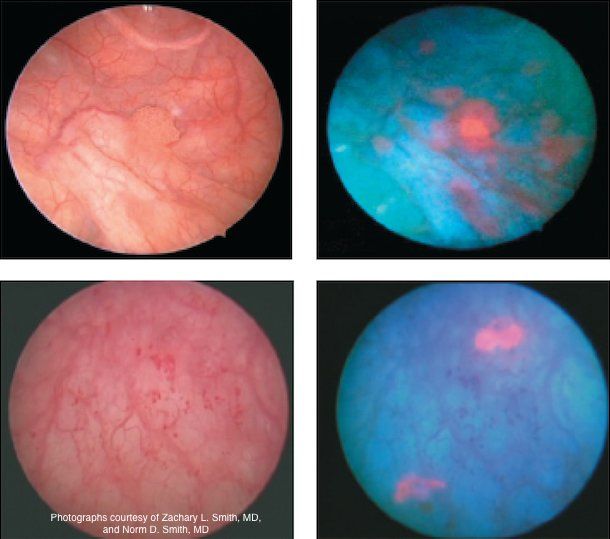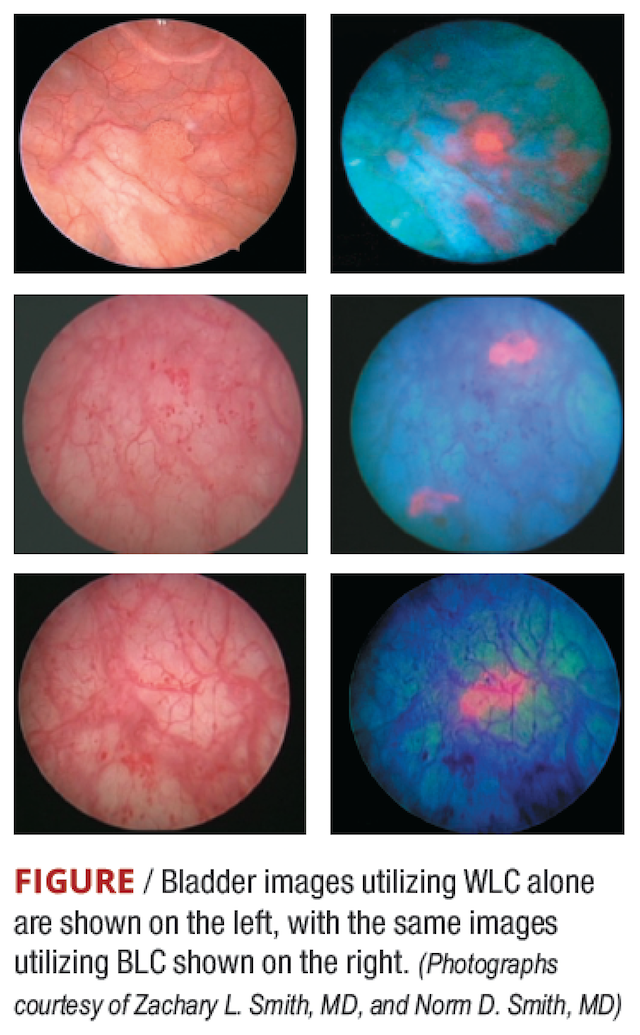Article
Role of blue light cystoscopy to detect bladder cancer
Author(s):
"Numerous clinical studies have exhibited significantly improved tumor detection rates with BLC," write Zachary L. Smith, MD, and Norm D. Smith, MD.
Photographs courtesy of Zachary L. Smith, MD, and Norm D. Smith, MD

Transurethral resection of bladder tumor (TURBT) is one of the most frequently performed procedures by urologists. However, for such a common procedure, rates of residual/understaged disease on restaging TURBT are startlingly high. Additionally, there remain high rates of persistent disease following intravesical therapy in those who did not receive a restaging TURBT. Both of these findings raise questions over the quality of TURBT many patients are receiving.
Also see: Top 5 bladder cancer articles of 2017
Accordingly, great effort has been put forth to develop more advanced techniques for the detection and eradication of tumors. Blue light cystoscopy (BLC) is one such technique, and carries many benefits over the historical standard of care, white light cystoscopy (WLC). Currently, the joint AUA and Society of Urologic Oncology (SUO) guidelines on nonmuscle-invasive bladder cancer (NMIBC) recommend offering BLC to all patients with NMIBC.
How BLC works
BLC involves instillation of a photosensitizer into the bladder prior to cystoscopy. This photosensitizer induces accumulation of protoporphyrins in rapidly proliferating cells (ie, malignant tumor cells). These protoporphyrins are then converted to photoactive porphyrins, which fluoresce red when illuminated with blue light (wavelength of 360–450 nm) (figure). Despite the multiple photosensitizing agents evaluated in clinical studies, the only agent currently approved for use in the United States by the FDA is hexaminolevulinate (HAL, marketed as Cysview).
Improved detection of tumors
Numerous clinical studies have exhibited significantly improved tumor detection rates with BLC. Meta-analyses and systematic reviews reveal a 7% to 29% increased rate of identifying small papillary tumors with BLC over WLC alone (Eur Urol 2013; 64:846-54; Eur Urol 2013; 64:624-38; Ther Adv Urol 2015; 7:339-50). The majority of increased detection of papillary lesions comes from Ta tumors, with minimal increased detection of T1 tumors (Ther Adv Urol 2015; 7:339–50).

However, the increased detection is substantially improved with carcinoma in situ (CIS), with a 15% to 41% increased rate of detection over WLC alone (Eur Urol 2013; 64:846-54; Eur Urol 2013; 64:624-38; Ther Adv Urol 2015; 7:339-50; J Urol 2007; 178:68-73). Importantly, BLC should be used as an adjunctive technique to WLC-not a replacement-since up to 15% of CIS lesions may be seen on WLC but not BLC (J Urol 2007; 178:68–73).
Next: Decreased tumor recurrence, progression
Decreased tumor recurrence, progression
The improved detection of tumors with BLC has demonstrated a resultant improvement in tumor recurrence. Meta-analyses have shown a 12% to 31% improvement in 12-month recurrence-free survival rates (Eur Urol 2013; 64:846-54; PLoS ONE 2013; 8:e74142). Improvements in progression rates are less clear-cut than those of recurrence rates. This may be due to two factors. First, there is a lack of consistency in the definition of “progression” among trials. Second, most trials are powered to detect changes in recurrence, not progression.
However, despite these limitations, BLC does appear to impact progression, albeit to a lesser degree than recurrence. In one randomized phase III trial, progression to muscle-invasive disease does not appear to be impacted
(J Urol 2012; 188:58-62). However, progression in grade and/or stage within the NMIBC disease state is improved by 5% (Bladder Cancer 2016; 2:273-8). Further, a meta-analysis revealed a 4% improvement in progression rates, but was limited by different definitions of progression among the included studies (Bladder Cancer 2016; 2:293-300).
Adoption of technique/application
While BLC represents a technique that many urologists may not have learned during their initial training, in the simplest of explanations it is merely a WLC with some changes in the colors visualized. While this is a minor difference, it does require a slight learning curve. A single-center study evaluating interobserver agreement found that 20 and 30 cases were required for good and excellent agreement, respectively (Can J Urol 2012; 19:6269-73).
This learning curve may vary from center to center depending on frequency of the technique’s use, with higher volume centers likely to see a shorter learning curve. This improvement is probably most important to avoid false positives from the increased fluorescence of benign inflammatory lesions.
Read: Immediate post-TURBT mitomycin instillation reduces recurrence risk
Further considerations when initially implementing BLC into one’s practice are those of its logistical and financial impact. BLC does require preoperative intravesical instillation of HAL with a dwell time of approximately 1 hour prior to the procedure. This may impact the workflow of some practice settings. However, in these authors’ experience, this implementation can be streamlined with minimal impact on workflow with appropriate education of the entire treatment team.
Regarding cost, an upfront investment in appropriate equipment is required to perform BLC. In the United States, the KARL STORZ D-Light C Photodynamic Diagnostic System is linked to the FDA’s approval of HAL. While the capital costs of this system may seem significant, BLC has been shown to carry a lower cost burden overall ($5,000 less over 5 years) given the lower cancer burden (Can J Urol 2013; 20:6682–9).
Conclusion
BLC is an adjunctive technique that should be considered for all patients with bladder cancer, particularly at the time of initial TURBT. Its increased tumor detection and resultant reduction in tumor recurrence and progression support its use as a cost-effective and successful method for decreasing overall tumor burden in NMIBC patients.
For these reasons, the use of BLC is recommended by the AUA/SUO as well as these authors.
More from Urology Times:
Cost considerations in the management of bladder cancer
Test could help detect bladder cancer recurrence
How will immunotherapy change the future of bladder Ca care?
Subscribe to Urology Times to get monthly news from the leading news source for urologists.

















